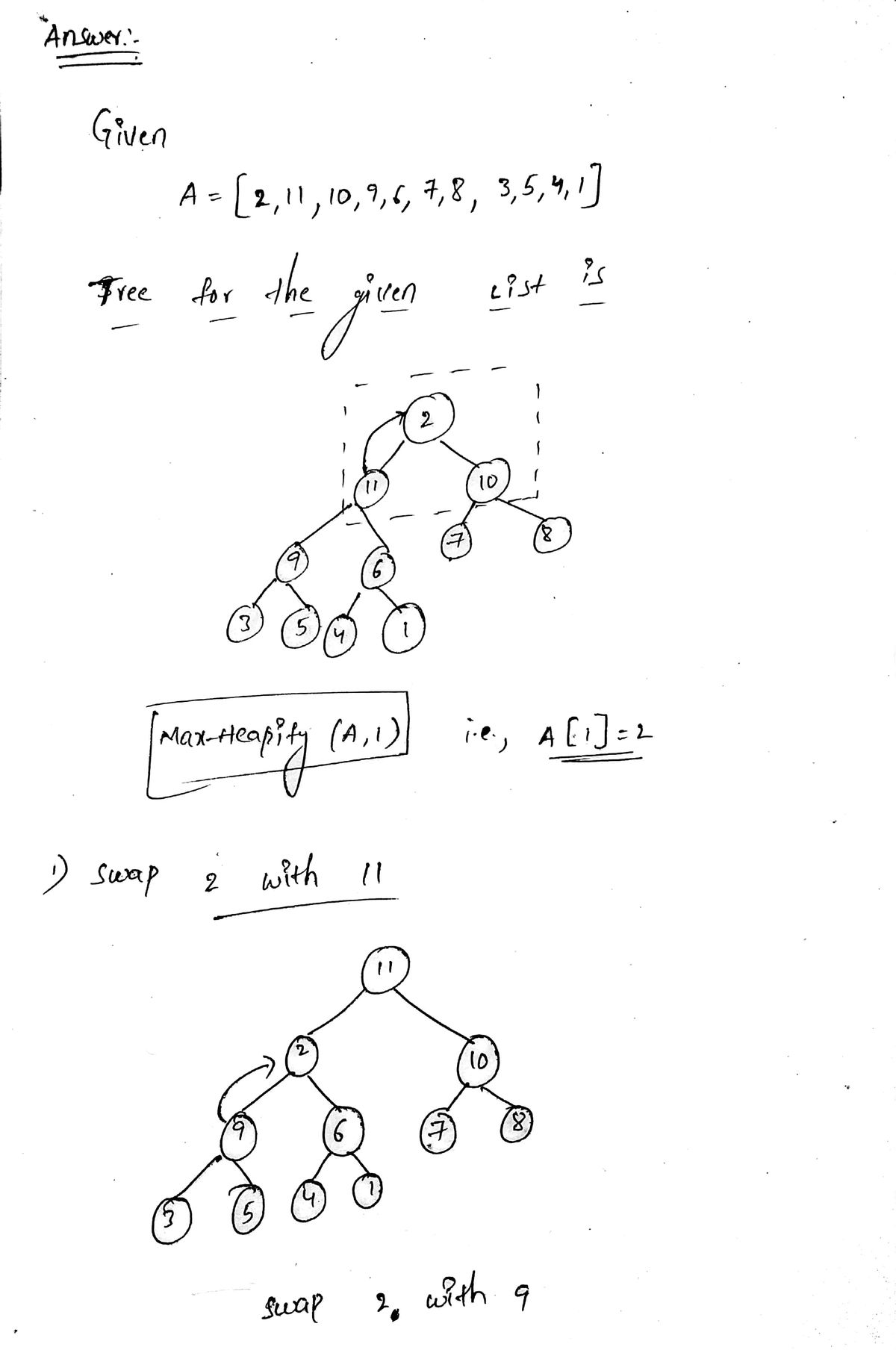In Heapsort, we assume that arrays are indexed from 1 to n. For example, if A = [16,4,10,14,7,9,3,2,8,1], then A[2] = 4 (highlighted in red). %3D The MAX-HEAPIFY(A, i) procedure inputs an array A and an index i. It assumes that the binary trees rooted at LEFT(i) and RIGHT(i) are max heaps, and ensures that A[i] "floats down" so that the output is an array that obeys the max-heap property. An example is provided on pg. 155 of the textbook. In this example, A = [16,4,10,14,7,9,3,2,8,1]. Then MAX-HEAPIFY(A, 2) %3D corrects the 2nd element of A, which is 4, moving this number to the correct position. The output is [16,14,10,8,7,9,3,2,4,1]. Let A = [2,11,10,9,6,7,8,3,5,4,1]. Determine MAX-HEAPIFY(A,1).
In Heapsort, we assume that arrays are indexed from 1 to n. For example, if A = [16,4,10,14,7,9,3,2,8,1], then A[2] = 4 (highlighted in red). %3D The MAX-HEAPIFY(A, i) procedure inputs an array A and an index i. It assumes that the binary trees rooted at LEFT(i) and RIGHT(i) are max heaps, and ensures that A[i] "floats down" so that the output is an array that obeys the max-heap property. An example is provided on pg. 155 of the textbook. In this example, A = [16,4,10,14,7,9,3,2,8,1]. Then MAX-HEAPIFY(A, 2) %3D corrects the 2nd element of A, which is 4, moving this number to the correct position. The output is [16,14,10,8,7,9,3,2,4,1]. Let A = [2,11,10,9,6,7,8,3,5,4,1]. Determine MAX-HEAPIFY(A,1).
Database System Concepts
7th Edition
ISBN:9780078022159
Author:Abraham Silberschatz Professor, Henry F. Korth, S. Sudarshan
Publisher:Abraham Silberschatz Professor, Henry F. Korth, S. Sudarshan
Chapter1: Introduction
Section: Chapter Questions
Problem 1PE
Related questions
Question
![In Heapsort, we assume that arrays are indexed from 1 to n. For
example, if A = [16,4,10,14,7,9,3,2,8,1], then A[2] = 4 (highlighted
in red).
%3D
%3D
The MAX-HEAPIFY(A, i) procedure inputs an array A and an index
i. It assumes that the binary trees rooted at LEFT(i) and RIGHT(1)
are max heaps, and ensures that A[i] "floats down" so that the
output is an array that obeys the max-heap property.
An example is provided on pg. 155 of the textbook. In this
example, A = [16,4,10,14,7,9,3,2,8,1]. Then MAX-HEAPIFY(A, 2)
corrects the 2nd element of A, which is 4, moving this number to
the correct position. The output is [16,14,10,8,7,9,3,2,4,1].
Let A = [2,11,10,9,6,7,8,3,5,4,1]. Determine MAX-HEAPIFY(A,1).](/v2/_next/image?url=https%3A%2F%2Fcontent.bartleby.com%2Fqna-images%2Fquestion%2Fe837985f-2989-4a25-a05d-02efdd5ff4d2%2F1d5b6f39-c9c4-497d-8f81-d0866ac7e4c7%2Fi5ogyfu_processed.png&w=3840&q=75)
Transcribed Image Text:In Heapsort, we assume that arrays are indexed from 1 to n. For
example, if A = [16,4,10,14,7,9,3,2,8,1], then A[2] = 4 (highlighted
in red).
%3D
%3D
The MAX-HEAPIFY(A, i) procedure inputs an array A and an index
i. It assumes that the binary trees rooted at LEFT(i) and RIGHT(1)
are max heaps, and ensures that A[i] "floats down" so that the
output is an array that obeys the max-heap property.
An example is provided on pg. 155 of the textbook. In this
example, A = [16,4,10,14,7,9,3,2,8,1]. Then MAX-HEAPIFY(A, 2)
corrects the 2nd element of A, which is 4, moving this number to
the correct position. The output is [16,14,10,8,7,9,3,2,4,1].
Let A = [2,11,10,9,6,7,8,3,5,4,1]. Determine MAX-HEAPIFY(A,1).
Expert Solution
Step 1

Trending now
This is a popular solution!
Step by step
Solved in 2 steps with 2 images

Knowledge Booster
Learn more about
Need a deep-dive on the concept behind this application? Look no further. Learn more about this topic, computer-science and related others by exploring similar questions and additional content below.Recommended textbooks for you

Database System Concepts
Computer Science
ISBN:
9780078022159
Author:
Abraham Silberschatz Professor, Henry F. Korth, S. Sudarshan
Publisher:
McGraw-Hill Education

Starting Out with Python (4th Edition)
Computer Science
ISBN:
9780134444321
Author:
Tony Gaddis
Publisher:
PEARSON

Digital Fundamentals (11th Edition)
Computer Science
ISBN:
9780132737968
Author:
Thomas L. Floyd
Publisher:
PEARSON

Database System Concepts
Computer Science
ISBN:
9780078022159
Author:
Abraham Silberschatz Professor, Henry F. Korth, S. Sudarshan
Publisher:
McGraw-Hill Education

Starting Out with Python (4th Edition)
Computer Science
ISBN:
9780134444321
Author:
Tony Gaddis
Publisher:
PEARSON

Digital Fundamentals (11th Edition)
Computer Science
ISBN:
9780132737968
Author:
Thomas L. Floyd
Publisher:
PEARSON

C How to Program (8th Edition)
Computer Science
ISBN:
9780133976892
Author:
Paul J. Deitel, Harvey Deitel
Publisher:
PEARSON

Database Systems: Design, Implementation, & Manag…
Computer Science
ISBN:
9781337627900
Author:
Carlos Coronel, Steven Morris
Publisher:
Cengage Learning

Programmable Logic Controllers
Computer Science
ISBN:
9780073373843
Author:
Frank D. Petruzella
Publisher:
McGraw-Hill Education